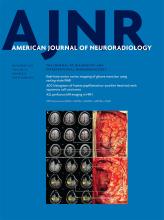Index by author
Lenoir, V.
- FELLOWS' JOURNAL CLUBHead and Neck ImagingOpen AccessApparent Diffusion Coefficient Histograms of Human Papillomavirus–Positive and Human Papillomavirus–Negative Head and Neck Squamous Cell Carcinoma: Assessment of Tumor Heterogeneity and Comparison with HistopathologyT. de Perrot, V. Lenoir, M. Domingo Ayllón, N. Dulguerov, M. Pusztaszeri and M. BeckerAmerican Journal of Neuroradiology November 2017, 38 (11) 2153-2160; DOI: https://doi.org/10.3174/ajnr.A5370
One hundred five consecutive patients with primary oropharyngeal and oral cavity head and neck squamous cell carcinoma underwent MR imaging with anatomic and DWI sequences. The collected tumor voxels from the contoured ROIs provided histograms from which position, dispersion, and form parameters were computed. Histogram data were correlated with histopathology, p16-immunohistochemistry, and polymerase chain reaction for human papillomavirus DNA. Diffusion phenotypes of human papillomavirus–positive and human papillomavirus–negative head and neck squamous cell carcinomas showed significant differences, which reflect their distinct degree of tumor heterogeneity.
Lin, C.-p.
- EDITOR'S CHOICEFunctionalOpen AccessReal-Time Motor Cortex Mapping for the Safe Resection of Glioma: An Intraoperative Resting-State fMRI StudyT.-m. Qiu, F.-y. Gong, X. Gong, J.-s. Wu, C.-p. Lin, B.B. Biswal, D.-x. Zhuang, C.-j. Yao, X.-l. Zhang, J.-f. Lu, F.-p. Zhu, Y. Mao and L.-f. ZhouAmerican Journal of Neuroradiology November 2017, 38 (11) 2146-2152; DOI: https://doi.org/10.3174/ajnr.A5369
The authors conducted preoperative and intraoperative resting-state intrinsic functional connectivity analyses of the motor cortex in 30 patients with brain tumors. Factors that may influence intraoperative imaging quality, including anesthesia type and tumor cavity, were studied. Additionally, direct cortical stimulation was used to validate the accuracy of intraoperative resting-state fMRI in mapping the motor cortex. Fourteen patients who successfully completed both sufficient intraoperative resting-state fMRI and direct cortical stimulation were used for further analysis of sensitivity and specificity. Compared with those subjected to direct cortical stimulation, the sensitivity and specificity of intraoperative resting-state fMRI in localizing the motor area were 61.7% and 93.7%, respectively. They conclude that using intraoperative resting-state fMRI can avoid the risk of intraoperative seizures due to direct cortical stimulation and may provide neurosurgeons with valuable information to facilitate the safe resection of gliomas.
Lin, E.P.
- Head and Neck ImagingOpen AccessThe Management and Imaging of Vestibular SchwannomasE.P. Lin and B.T. CraneAmerican Journal of Neuroradiology November 2017, 38 (11) 2034-2043; DOI: https://doi.org/10.3174/ajnr.A5213
Lis, E.
- Spine Imaging and Spine Image-Guided InterventionsOpen AccessT1-Weighted Dynamic Contrast-Enhanced MR Perfusion Imaging Characterizes Tumor Response to Radiation Therapy in ChordomaP. Santos, K.K. Peck, J. Arevalo-Perez, S. Karimi, E. Lis, Y. Yamada, A.I. Holodny and J. LyoAmerican Journal of Neuroradiology November 2017, 38 (11) 2210-2216; DOI: https://doi.org/10.3174/ajnr.A5383
Lownie, S.P.
- LetterYou have accessSelective Poststent Balloon Angioplasty for Carotid StentingD.M. Pelz and S.P. LownieAmerican Journal of Neuroradiology November 2017, 38 (11) E97; DOI: https://doi.org/10.3174/ajnr.A5346
Lu, J.-f.
- EDITOR'S CHOICEFunctionalOpen AccessReal-Time Motor Cortex Mapping for the Safe Resection of Glioma: An Intraoperative Resting-State fMRI StudyT.-m. Qiu, F.-y. Gong, X. Gong, J.-s. Wu, C.-p. Lin, B.B. Biswal, D.-x. Zhuang, C.-j. Yao, X.-l. Zhang, J.-f. Lu, F.-p. Zhu, Y. Mao and L.-f. ZhouAmerican Journal of Neuroradiology November 2017, 38 (11) 2146-2152; DOI: https://doi.org/10.3174/ajnr.A5369
The authors conducted preoperative and intraoperative resting-state intrinsic functional connectivity analyses of the motor cortex in 30 patients with brain tumors. Factors that may influence intraoperative imaging quality, including anesthesia type and tumor cavity, were studied. Additionally, direct cortical stimulation was used to validate the accuracy of intraoperative resting-state fMRI in mapping the motor cortex. Fourteen patients who successfully completed both sufficient intraoperative resting-state fMRI and direct cortical stimulation were used for further analysis of sensitivity and specificity. Compared with those subjected to direct cortical stimulation, the sensitivity and specificity of intraoperative resting-state fMRI in localizing the motor area were 61.7% and 93.7%, respectively. They conclude that using intraoperative resting-state fMRI can avoid the risk of intraoperative seizures due to direct cortical stimulation and may provide neurosurgeons with valuable information to facilitate the safe resection of gliomas.
Lyo, J.
- Spine Imaging and Spine Image-Guided InterventionsOpen AccessT1-Weighted Dynamic Contrast-Enhanced MR Perfusion Imaging Characterizes Tumor Response to Radiation Therapy in ChordomaP. Santos, K.K. Peck, J. Arevalo-Perez, S. Karimi, E. Lis, Y. Yamada, A.I. Holodny and J. LyoAmerican Journal of Neuroradiology November 2017, 38 (11) 2210-2216; DOI: https://doi.org/10.3174/ajnr.A5383








